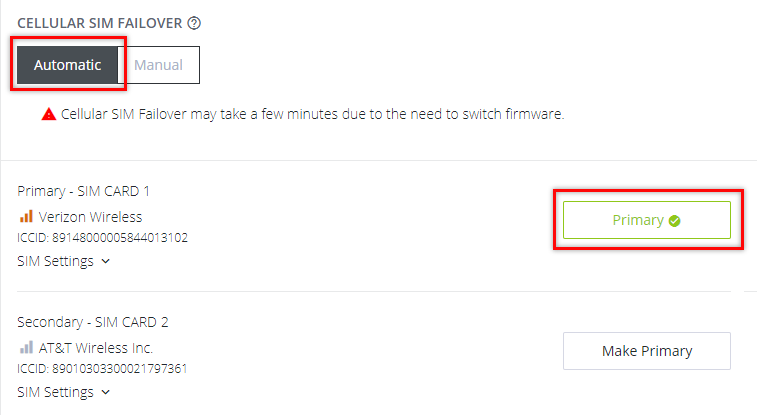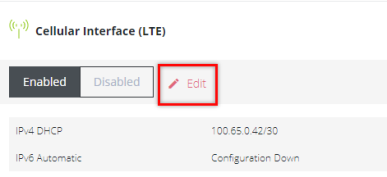Dual SIM Automatic Failover
CONFIGURE > NETWORK CONNECTIONS> Network Interfaces > Cellular Interface (LTE)
Operations Manager that carry two SIM cards can be configured so that either SIM card slot may be activated. In Automatic failover mode, either of the two SIM cards may be designated as the Primary SIM. (see Dual SIM).
Dual SIM Automatic Failover works seamlessly with the existing failover solution to provide another layer of redundancy. This feature allows the software to detect a failure in OOB communications via the Primary SIM and will automatically failover to the Secondary SIM without the need for manual operator intervention.
Options within the configuration also allow you to configure the failback settings from Secondary SIM, back to the previous Primary SIM when OOB communications have been restored. See Cellular Interface Policy Settings.
Note:The terminology changes when SIM Failover policy is switched from Manual to Automatic. In Manual mode the active SIM is designated ACTIVE, whereas in Automatic failover mode the active SIM is designated PRIMARY.
See the image on the following page for a depiction of Primary and Secondary SIM card slots.
Either of the SIM card slots can be designated as the Primary SIM. In the following image, SIM card 1 has been designated as the Primary SIM and is currently the active SIM, while SIM card 2 is designated as the Secondary SIM which, (in the scenario below), is only activated in the event of an automatic failover such as occurs during an OOB communications failure on the Primary SIM.

Failover Modes
Features of Automatic Failover include:
-
Select either Manual or Automatic SIM failover.
-
Specify SIM failback policy (applicable when the Ethernet connection and primary SIM are both down):
-
Upon disconnect - See the table Cellular Interface Policy Settings for an explanation of the policy.
-
After a Delay (specified in minutes) - The node switches back to primary after a pre-defined time has elapsed.
-
Never - The node never switches back to the Primary.
-
-
SIM failover settings allow you to configure the parameters that affect cellular data usage, for example, quicker failover (consumes more data) vs less frequent tests (consumes less data). The configuration preferences include
-
Ping test for failover from Primary to Secondary and failback from Secondary to Primary.
-
Failover settings are per SIM slot and consist of a failover and failback ping test.
-
-
Automatic Failover functions in both dormant and non-dormant mode.
Activate or Configure Automatic Failover
CONFIGURE > NETWORK CONNECTIONS> Network Interfaces > Cellular Interface (LTE) > Manage Cellular Interface (LTE)
-
Navigate to the Cellular Interface page at: CONFIGURE > NETWORK CONNECTIONS> Network Interfaces > Cellular Interface (LTE).
-
Click the Edit link next to the Cellular Interface Enabled/Disabled switch.

-
In the Manage Cellular Interface page, select the Automatic failover option.
-
Ensure the correct SIM card is selected as the Primary SIM (see 'Set Primary SIM' in Dual SIM).
-
Complete the Cellular Interface options in accordance with the table below.
-
Click Confirm to activate the failover policy settings, a green banner will confirm the settings are enabled.
Cellular Interface Policy Settings
| MANAGE CELLULAR INTERFACE (LTE) Properties | |
|---|---|
| Field | Definition |
| CELLULAR SIM FAILOVER - Manual/Automatic. | Automatically switch between the Primary SIM Card and the secondary SIM Card on disconnection. |
| Primary SIM Failover | |
| Failover Probe Address. | Network address to probe in order to determine if connection is active. Note: The probe address accepts IPv4, IPv6 addresses and hostnames. |
| Test interval (seconds). | The number of seconds between connectivity probe tests. |
| Pings per test. | The maximum number of times a single ping packet is sent per probe before considering the probe failed. |
| Consecutive test failures before failover. | The number of times a probe must fail before the connection is considered failed. |
| Failback Policy | |
| Never / Delayed / On Disconnect. | Select the policy to be used to determine Failback recovery from the Secondary SIM Card back to the Primary SIM Card. |
| Never | No Failback recovery is attempted. |
| Delayed | Attempted failback after n minutes. The number of minutes after failover to the secondary SIM Card that the connection should failback to the Primary SIM Card. |
| On Disconnect | Secondary SIM Failback |
| Failback Probe Address
ie. The Network address to probe in order to determine if the connection is active. |
|
| Test Interval
The number of seconds between connectivity probe tests (this not the same thing as Attempted Failback). |
|
| Pings per Test
The maximum number of times a single ping packet is sent per probe before considering the probe failed. |
|
| Consecutive Test Failures (before failover)
The number of times a probe must fail before the connection is considered failed. |
|